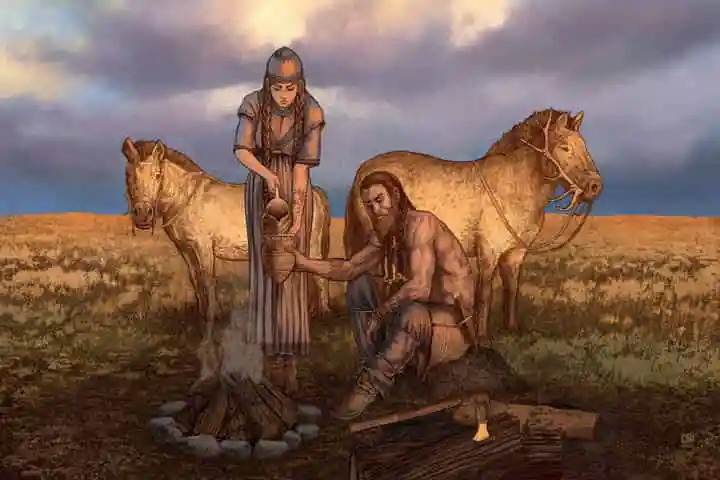

Illustration of Yamnaya life (Pic. Courtesy Twitter/@hall_sloan)
<p>
<strong>Researchers have always been intrigued as to how Yamnaya, the nomads expanded from the grasslands of today&rsquo;s Russia and Ukraine to stretch across Eurasia within a few centuries.</strong></p>
<p>
Helping unravel this mystery now is the fossilised plaque from the teeth of 50 Bronze Age skeletons which lead to the clue that it was milk that steamed their growth, making them leave a genetic signature from Mongolia to Hungary, according to an article in science.org.</p>
<p>
Speaking on this aspect, Wolfgang Haak, an archaeogeneticist at the Max Planck Institute for Evolutionary Anthropology said: <a href="https://www.science.org/content/article/milk-fueled-bronze-age-expansion-eastern-cowboys-europe">&ldquo;It&rsquo;s great to see this type of evidence finally there.</a> It&rsquo;s a convincing argument as far as dairy is concerned.&rdquo; Haak who refers to Yamnaya as &ldquo;eastern cowboys&rdquo; was not a part of the research.</p>
<p>
<img alt="" src="https://www.indianarrative.com/upload/news/Skeleton_Remains_Of_Yamnayas_Twitter_aaaksara.jpg" style="width: 720px; height: 480px;" /></p>
<p>
<strong><em>Skeleton Remains Of A Yamnaya (Pic. Courtesy Twitter/@aaaksara)</em></strong></p>
<p>
In the past, scientists hypothesized that it was an amalgam of dairying, wagons and horseback that made it possible for Yamnaya to become mobile thereby resulting in expansion but there was no direct evidence except for a few wagon burials and pottery sherds.</p>
<p>
To be able to understand what fuelled their success, scientists and experts from Russia, United States and Europe, studied the milk proteins which had been stuck and preserved for centuries in the plague of the people who resided in modern day Russia&rsquo;s steppes between 4600 and 1700 BCE.</p>
<p>
On examining 56 skeletons which had come from more than 24 sites north of the Caspian Sea, the group separated the proteins preserved from the mineral matrix of the plaque. Following this in order to identify individual proteins, they used mass spectrometry.</p>
<p>
<img alt="" src="https://www.indianarrative.com/upload/news/Reconstruction_Of_A_Yamnaya_Man_Twitter_RealSeedCo.jpg" style="width: 720px; height: 480px;" /></p>
<p>
<strong><em>Reconstruction of the face of a Yamnaya man (Pic. Courtesy Twitter/@RealSeedCo)</em></strong></p>
<p>
The plague of people who lived before 3300 BCE along the Volga and Don river settlements had virtually no milk proteins. The pre-Yamnaya populace, it seems, ate plenty of freshwater fish, wild game, and also made a meal of their domesticated animals like sheep, goat and cow. This is what the earlier analysis of isotopes in their skeletons and animal bones found at the sites revealed.</p>
<p>
The dramatic shift and change took place around 3300 BCE as the samples scraped from the teeth of the people after that year yielded proteins of milk from sheep, goat and cow. This qualified as direct evidence of eating dairy products. What is amazing is the presence of preserved horse milk traces.</p>
<p>
Lead author of the study Shevan Wilkin who is a biomolecular archaeologist at the University of Zurich Institute of Evolutionary Medicine observed: &ldquo;There&rsquo;s a cultural switch. It&rsquo;s a huge change of perspective from &lsquo;we eat these animals sometimes&rsquo; to &lsquo;we milk them all the time&rsquo;.&rdquo;</p>
<p>
<strong>Also read: </strong><a href="https://www.indianarrative.com/culture-news/pre-hispanic-civilisation-pictogram-reported-about-earthquakes-in-mexico-and-central-america-113454.html"><strong>Pre-Hispanic civilisation pictogram reported about 12 earthquakes in Mexico and Central America</strong></a></p>
<p>
Presence of the proteins points out that use of herding and dairying was pivotal to the rapid change of the Yamnaya from hunter-gatherers to nomadic herders which assisted their growth in just a short time frame of 300 years, according to experts. Co-author and archaeologist from Hartwick College remarked: &ldquo;Horses, cattle, sheep, and goats turned grass into food, clothing, and shelter. The Yamnaya invented a new economy.&rdquo;</p>
<p>
But it was not just dairy that worked the magic as the advent of wagons around the same time made it possible to ferry water and also take out animals to pastures far away for grazing. Also the taming of horses gave an additional advantage of controlling herds bigger in number.</p>
<p>
University of Helsinki archaeologist Volker Heyd averred: &ldquo;Milk is a contributing factor, but not the only factor. It&rsquo;s a new economy and a new way of life, and the origins are the invention of the wheel, horse riding, and dairying.&rdquo;</p>
<p>
<strong>Also read: </strong><a href="https://www.indianarrative.com/culture-news/native-americans-built-structures-that-lasted-years-112779.html"><strong>Native Americans built structures that lasted 3,000 Years</strong></a></p>
<p>
However, there is still a big riddle to be solved. DNA analysis done in the past have reflected that the Yamnaya were lactose intolerant &ndash; they were devoid of the genetic ability to metabolise milk sugars. Wilkin argued it is possible that like today&rsquo;s Mongolians, the Yamnaya had dairy products that were fermented. Like for example, hard cheese and yogurt that have virtually no lactose.</p>
Over the last ten years, India’s global footprint has expanded thereby ensuring India’s voice resonates…
The Indian government has launched Operation Sindhu to evacuate Indian nationals from Iran in view…
Amid the evolving situation in West Asia, Indian and Israeli Defence officials spoke to each…
Croatian Prime Minister Andrej Plenkovic praised India's growing global leadership, citing its bold and inclusive…
Prime Minister Narendra Modi's maiden visit to Croatia marks a significant milestone in the India-Croatia…
Prime Minister Narendra Modi interacted with members of the Indian diaspora here on Wednesday as…